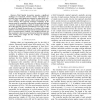17 search results - page 3 / 4 » 3D Challenges and a Non-In-Depth Overview of Recent Progress |
IROS
2009
IEEE
13 years 12 months ago
2009
IEEE
— Fluid bipedal locomotion remains a significant challenge for humanoid robotics. Recent bio-inspired approaches have made significant progress by using small numbers of tightl...
PAMI
2011
13 years 7 days ago
2011
—The field of Action Recognition has seen a large increase in activity in recent years. Much of the progress has been through incorporating ideas from single frame object recogn...
ISBI
2006
IEEE
14 years 6 months ago
2006
IEEE
Recent advances in bio-molecular imaging have afforded biologists a more thorough understanding of cellular functions in complex tissue structures. For example, high resolution fl...
NAR
2000
13 years 5 months ago
2000
Maintained at the University of Texas Health Science Center at Tyler, Texas, the tmRNA database (tmRDB) is accessible at the URL http://psyche.uthct.edu/dbs/ tmRDB/tmRDB.html with...
SAGT
2010
Springer
13 years 3 months ago
2010
Springer
The PPAD-completeness of Nash equilibrium computation is taken as evidence that the problem is computationally hard in the worst case. This evidence is necessarily rather weak, in ...

